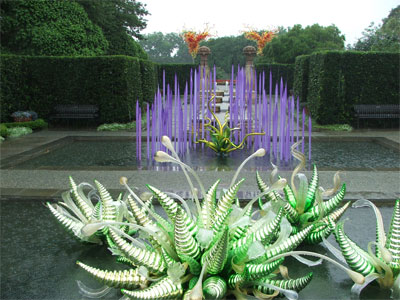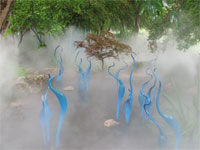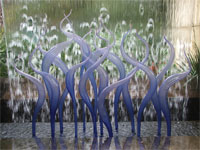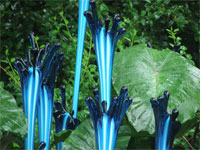Native Son – May, 2012
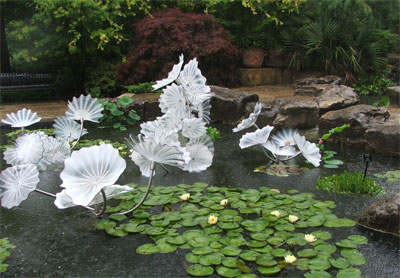
Ethereal glass water lilies by Dale Chihuly float across a Dallas Arboretum pond in tandem with delicate water lilies by Mother Nature. All photos by Steven Chamblee.
Dallas Arboretum
Still reeling from my four-talks-in-four-days road trip blow-out to East Texas, I suddenly get this e-mail that leads to a quick phone call that leads to a donation of caladium bulbs that leads to, you guessed it, another road trip. Only problem this time is the destination … northeast Dallas — a major problem for a guy who is allergic to traffic. Fortunately, I have seen enough promotion for The Avengers movie to bolster my fool-hearty machismo, so off I go, into the belly of the beast.
Truth be told, traffic isn’t that bad, and a gentle rain creates petroleum rainbows across the pavement whenever there’s a gap between cars. Semi-trucks boil up clouds behind them just to add a little drama to the scene, and for once, US 75 doesn’t turn into a linear parking lot. Hmmm … I suppose The Avengers are already on the job.
I greet a group of cheery gents with Australian accents as I enter the bulb warehouse, where I’m inspired to let rip a robust “Wooooooo Pig Sooooooie!” at the sight of an office all decked out with University of Arkansas memorabilia. Not sure what the bossman thought of that, but hey, it’s raining, so a little insanity is in order. Soon, I am all loaded up (actually, the truck is loaded up … I’m always this way) and ready to go. I figure I might as well visit the Dallas Arboretum’s Chihuly exhibit while I’m in the neighborhood, so I follow a quirky little napkin map through serpentine streets until, lo and behold, there she is.
Just as I open the truck door, the heavens open up and it begins to really pour … perfect. Fortunately, I still have an umbrella behind the seat … one of those giant golf jobs that can double as a patio awning when you’re in a pinch. I open ‘er up and glance across the parking lot … people are flowing out of the Arboretum like lava. I laugh out loud … perfect!
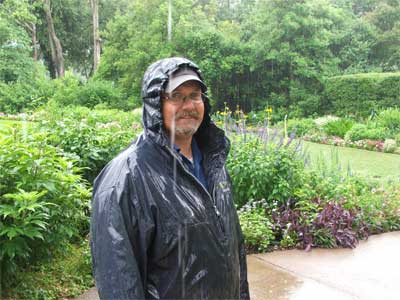
Tucker Reed (Arboretumus horticultus)
Fifty feet inside the gate, I am kidnapped by Tucker Reed, one of the horticulturists running amuck around here, and we golf cart it to the far end of the Paseo, laughing and yukking it up all the way. Tucker is essentially a younger version of me, except he’s smarter, thinner, more energetic, and better looking. (I’ll bet his feet smell bad….) Anyway, after some inspired conversation, he tells me he has to go home and get into his spandex Captain America outfit, so he drops me off … and there I stand, totally soaked, all alone, right in the middle of a world-class glass exhibit holding a Volkswagen-sized umbrella that has somehow managed to keep my camera dry. Perfect!
As expected, Chihuly delivers another incredibly-colored, phantasmal-shaped, mind-bending display that would make Dr. Seuss utter, “Now that’s imagination.” I giggle a special little giggle normally reserved for 10-year-old cousins in the back pew of a packed church house. The rain pounds on while I’m taking photos, sloshing around, and generally behaving like an idiot. BUT, I’m a happy idiot. A perfectly happy idiot.
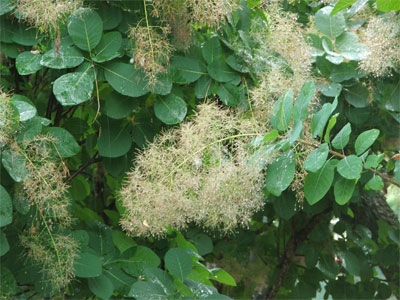
American smoketree (Cotinus obovatus)
After a few minutes, I find a covered porch and get to thinking about writing this month’s Native Son article. I just drove 800 miles through the Texas springtime — Weatherford to Quitman to Tyler to Nacogdoches to Tomball to Athens to Weatherford — did I take photos of a feature plant? Now I’m here in Jimmy Turner’s playground … beautiful, but are there Texas native plants? Of course there are. Familiar live oaks, cedar elms, and magnolias are everywhere. My favorites are the old bois d’arc trees, their ancient trunks covered in burls and craggy bark, hiding that bright yellow wood from passersby. Almost impossibly, a smoke tree, another yellow-wooded tree, blooms nearby. The large leaves lead me to believe this is a native American Smoke Tree (Cotinus obovata), a small tree native to a tiny area of Texas, down near Uvalde and Bandera. The nearest other native population is some 500 miles away in Oklahoma, and there are a few other small populations scattered through the southeastern United States. Considered “relictual,” it is a remnant (or relic) from larger populations that once covered substantial areas of the southern U.S. That yellow wood yielded a dye so popular during the Civil War era that almost all the smoke trees were felled. Few of these native trees are grown in nurseries, as the European smoke tree (C. coggygria) is a bit showier and often features purple leaves. In either case, the “smoke tree” name comes from the fluffy inflorescences, which appear like little puffs of smoke from a distance. As I’m taking my third photo of this special tree, I almost trip over the label: Cotinus coggygria ‘Grace’, which means it’s a European smoke tree. But it looks just like the American version. A quick phone Google and it all comes together — ‘Grace’ is a hybrid between the two species that features the large leaves of the American species with the bigger inflorescence of the European species. So here I am, drenched and flummoxed, but still learning.
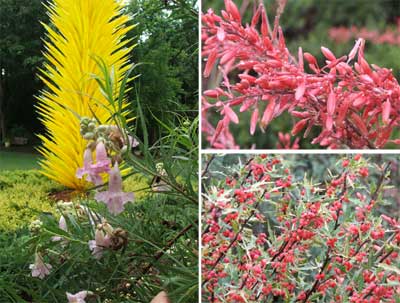
Left photo: Desert willow (Chilopsis linearis). Top right photo: Red yucca blossom (Hesperaloe parviflora). Bottom right photo: Agarita fruit (Mahonia triofoliolata).
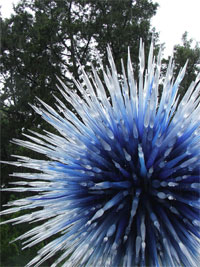
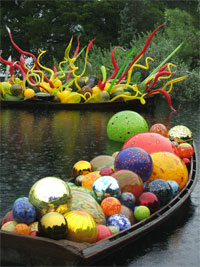
Splooshing my way through the garden, other native Texas plants appear before me: oakleaf hydrangea, pickerelweed, elderberry, desert willow, red yucca, and agarita. The last three are particularly well suited for companion planting in water-wise gardens. Interestingly enough, I have never really noticed, until this very moment, that that unusual salmon-coral color is shared by the red yucca bloom and the agarita fruit. Maybe I just never paid attention. Maybe I was unenlightened. Maybe I am suffering from “The Chihuly Effect.”
I have seen Chuhuly’s work before … last summer in Columbus, Ohio’s Franklin Park Conservatory. The glass works were imbedded among thick tropical leaves, peeking out to bring a mysterious element to the jungle. I loved it, loved every minute of it. But today seems so different. The glass seems much more intense … yet approachable … even vulnerable. Why does it affect me so intensely today? Is it the solitude? Is it the rain? Have I changed that much in 10 months? Ducks fly over my head as I contemplate this, as if to assist this hapless human in figuring out the obvious. The sky, silly boy, the sky!
I have lived long enough to know that beauty surrounds us all, every single day. We just have to have the wisdom/enlightenment/openness to see it. Hundreds of people ran out of this lovely garden because of a rainstorm. Nothing wrong with that; it’s rational. I stand here now, entranced in the moment, soaked in life-giving rain, witness to the magnificent mix of flora, fauna, water, and man’s imagination, wrought from sand and fire. What a feeling. What a moment. Simply … perfect.
About the author: Steven Chamblee is the chief horticulturist for Chandor Gardens in Weatherford and a regular contributor to Neil Sperry’s GARDENS magazine and e-gardens newsletter. Steven adds these notes:
Come out to the gardens before it gets hot. Just take I-20 west to exit 409, hang a right, go 2.1 miles and hang a left on Lee Avenue. Head straight 12 blocks and you’re driving in the gates. Call 817-361-1700 for more information. You can always go to http://www.ci.weatherford.tx.us/index.aspx?nid=170 for a picture tour and details.
I can always use another road trip! Let me know if you’d like me to come out and speak to your group sometime. I’m low-maintenance, flexible, and you know I like to go just about anywhere. No city too big; no town to small. Just send me an e-mail at schamblee@weatherfordtx.gov and we’ll work something out.

